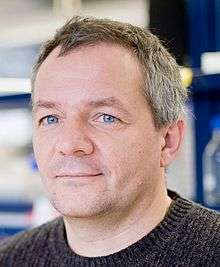Ralf Kaldenhoff
| Ralf Kaldenhoff | |
|---|---|
 | |
| Residence | Germany |
| Nationality | German |
| Fields | Botany |
| Institutions | Technical University of Darmstadt |
| Known for | Aquaporins |
Ralf Kaldenhoff (* 2 October 1958) is a German botanist and professor for applied plant sciences at the Technical University of Darmstadt. He is known for his work on the aquaporin protein class, where he detected facilitated diffusion of CO2 in plant tissue and cells and in chloreoplasts respectively.
Life
Rald Kaldenhoff studied biology at the University of Hannover. In 1986 he received a PhD for his work on the thesis Genexpression during the Initial Phase of Blue Light Dependent Chloroplast Differentiation. From 1989-91 Kaldenhoff held a Max-Planck fellowship working at the Max Planck Institute for Molecular Genetics in Berlin. In 1991 he was appointed assistant professor at the University of Hannover. In 1996 he changed to the Julius-von-Sachs-Institute for Biosciences at the University of Würzburg as a full professor in molecular plant physiology. In 2003 he received a call to the Technical University of Darmstadt. Here he is head of the section Applied Plant Sciences since then.
Scientific contribution
Kaldenhoff was one of the first scientists to describe plant aquaporins.[1] He initially accomplished to analyse the function and localization of these proteins in plants as components of facilitated cellular water diffusion[2][3][4] and also proved their existence in plant tissues.[5][6] Pioneering was Kaldenhoff’s discovery that under investigation some of the aquaporin proteins facilitate the diffusion of CO₂ in plant tissues and cells and in chloroplasts respectively.[7][8][9][10] This detection revealed a yet unknown component of the photosynthesis mechanism.[11] The fact that a protein could facilitate gas diffusion changed the model of gas diffusion in all organisms.[12] For the first time, Kaldenhoff could provide evidence that an aquaporin molecule could conduct CO₂.[13] Kaldenhoff also worked on the interaction of parasitic plants with hosts and studied respective molecular mechanisms. This knowledge could be transferred into an application used for antagonizing these parasites. Currently Kaldenhoff and coworkers are developing procedures to cultivate micro algae in large-scale facilities for production of proteins, fatty acids, vitamins and natural ingredients for different industries. To explore basic scientific knowledge and transfer this information in applications useful for human life is the aim of Kaldenhoff’s work. Kaldenhoff published more than 80 papers including five patents.
International sojourns
- 1994 The Ohio State University, Columbus, USA: visiting scientist, Labor Prof. R. Hangarter.
- 1995 Osaka City University, Osaka, Japan: Fellowship of Yamada Science Foundation.
External links
References
- ↑ Kaldenhoff, R., A. Kolling, and G. Richter, A Novel Blue Light-Inducible and Abscisic Acid-Inducible Gene of Arabidopsis-Thaliana Encoding An Intrinsic Membrane-Protein. Plant Molecular Biology, 1993. 23(6): p. 1187-1198.
- ↑ Kaldenhoff, R., A. Kolling, J. Meyers, U. Karmann, G. Ruppel, and G. Richter, The blue light-responsive AthH2 gene of Arabidopsis thaliana is primarily expressed in expanding as well as in differentiating cells and encodes a putative channel protein of the plasmalemma. The Plant journal : for cell and molecular biology, 1995. 7(1): p. 87-95
- ↑ Biela, A., K. Grote, B. Otto, S. Hoth, R. Hedrich, and R. Kaldenhoff, The Nicotiana tabacum plasma membrane aquaporin NtAQP1 is mercury-insensitive and permeable for glycerol. The Plant journal : for cell and molecular biology, 1999. 18(5): p. 565-70.
- ↑ Siefritz, F., M.T. Tyree, C. Lovisolo, A. Schubert, and R. Kaldenhoff, PIP1 plasma membrane aquaporins in tobacco: from cellular effects to function in plants. Plant Cell, 2002. 14(4): p. 869-76.
- ↑ Otto, B. and R. Kaldenhoff, Cell-specific expression of the mercury-insensitive plasma-membrane aquaporin NtAQP1 from Nicotiana tabacum. Planta, 2000. 211(2): p. 167-72.
- ↑ Otto, B., N. Uehlein, S. Sdorra, M. Fischer, M. Ayaz, X. Belastegui-Macadam, M. Heckwolf, M. Lachnit, N. Pede, N. Priem, A. Reinhard, S. Siegfart, M. Urban, and R. Kaldenhoff, Aquaporin tetramer composition modifies the function of tobacco aquaporins. Journal of Biological Chemistry, 2010. 285(41): p. 31253-60.
- ↑ Uehlein, N., C. Lovisolo, F. Siefritz, and R. Kaldenhoff, The tobacco aquaporin NtAQP1 is a membrane CO₂ pore with physiological functions. Nature, 2003. 425(6959): p. 734-7.
- ↑ Uehlein, N., B. Otto, D. Hanson, M. Fischer, N. McDowell, and R. Kaldenhoff, Function of Nicotiana tabacum aquaporins as chloroplast gas pores challenges the concept of membrane CO₂ permeability. Plant Cell, 2008. 20(3): p. 648-57.
- ↑ Flexas, J., M. Ribas-Carbo, D.T. Hanson, J. Bota, B. Otto, J. Cifre, N. McDowell, H. Medrano, and R. Kaldenhoff, Tobacco aquaporin NtAQP1 is involved in mesophyll conductance to CO₂ in vivo. Plant Journal, 2006. 48(3): p. 427-39.
- ↑ Heckwolf, M., D. Pater, D.T. Hanson, and R. Kaldenhoff, The Arabidopsis thaliana aquaporin AtPIP1;2 is a physiologically relevant CO transport facilitator. The Plant journal : for cell and molecular biology, 2011. 67(5): p. 795-804.
- ↑ Evans, J.R., R. Kaldenhoff, B. Genty, and I. Terashima, Resistances along the CO₂ diffusion pathway inside leaves. Journal of Experimental Botany, 2009. 60(8): p. 2235-48.
- ↑ Kaldenhoff, R., Mechanisms underlying CO₂ diffusion in leaves. Current Opinion in Plant Biology, 2012. 15(3): p. 276-281.
- ↑ Uehlein, N., B. Otto, A. Eilingsfeld, F. Itel, W. Meier, and R. Kaldenhoff, Gas-tight triblock-copolymer membranes are converted to CO(2) permeable by insertion of plant aquaporins. Sci Rep, 2012. 2: p. 538.